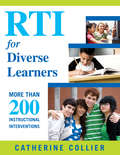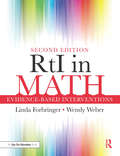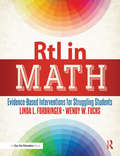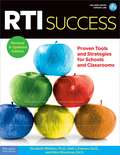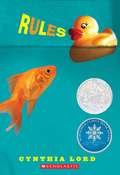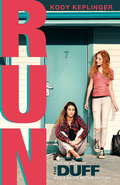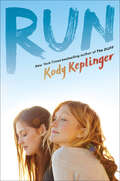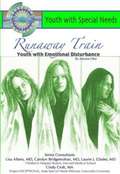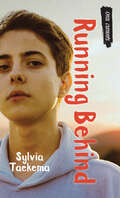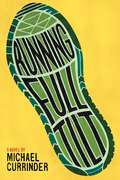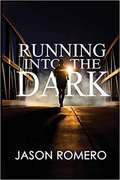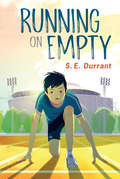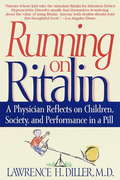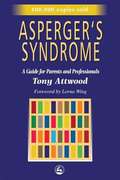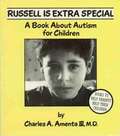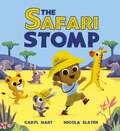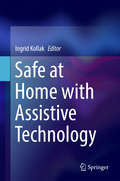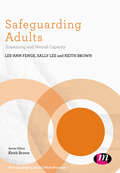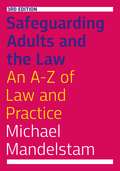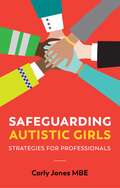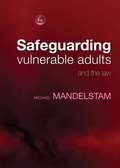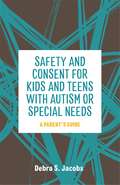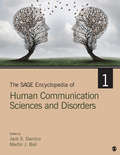- Table View
- List View
RTI for Diverse Learners: More Than 200 Instructional Interventions
by Catherine C. CollierProvide targeted instruction to ELLs and other diverse learners! Many Response to Intervention (RTI) models were developed to identify specific learning disabilities in English-speaking students. This research-based resource provides more than 200 instructional interventions for using RTI with students from culturally and linguistically diverse backgrounds in Grades K–12, especially non-native English speakers and those with limited English proficiency. This book features: Interventions for students' cognitive, behavior, literacy, and communication issues at each tier of a multi-tier RTI framework A reader-friendly format and straightforward directions for using each intervention Examples from practice and a glossary to aid implementation
RtI in Math: Evidence-Based Interventions
by Linda Forbringer Wendy WeberLearn how to help K–8 students who struggle in math. Now in its second edition, this book provides a variety of clear, practical strategies that can be implemented right away to boost student achievement. Discover how to design lessons that work with struggling learners, implement math intervention recommendations from the Institute of Education Sciences Practice Guides, the National Center on Intensive Intervention, and CEC, use praise and self-motivation more effectively, develop number sense and computational fluency, teach whole numbers and fractions, increase students’ problem-solving abilities, and more! This edition features an all-new overview of effective instructional practices to support academic engagement and success, ideas for intensifying instruction within tiered interventions, and a detailed set of recommendations aligned to both CCSSM and CEC/CEEDAR’s High-Leverage Practices to help support students struggling to meet grade-level expectations. Extensive, current examples are provided for each strategy, as well as lesson plans, games, and resources.
RtI in Math: Evidence-Based Interventions for Struggling Students
by Wendy Fuchs Linda ForbringerLearn how to help K–8 students who struggle in math. This book provides a variety of clear, practical strategies that can be implemented right away to boost student achievement. You will find out how to design lessons that work with struggling learners, implement the recommendations for math intervention from the What Works Clearinghouse, use praise and self-motivation more effectively, develop number sense and computational fluency, teach whole numbers and fractions, increase students’ problem-solving abilities, and more! Extensive examples are provided for each strategy, as well as lesson plans, games, and resources.
RTI Success: Proven Tools And Strategies For Schools And Classrooms
by Elizabeth Whitten Kelli J. Esteves Alice WoodrowThis practical, ready-to-use resource gives teachers and administrators the tools to successfully implement RTI or strengthen an existing program to target students' specific needs. Response to Intervention allows educators to assess and meet the needs of struggling students before they have fallen too far behind. Three expert authors explore this multi-tiered system of support (MTSS), offering over one hundred research-based, instructional techniques and interventions for use in diverse settings, advice on creating personal and positive learning environments, information on co-teaching, and approaches to purposeful grouping. Included in the book and as digital downloads are easy-to-use customizable forms to streamline assessment, implementation, and documentation. Also included is an extensive list of references and resources for further exploration.
Rules
by Cynthia LordThis 2007 Newbery Honor Book is a humorous and heartwarming debut about feeling different and finding acceptance. Now in After Words paperback! Twelve-year-old Catherine just wants a normal life. Which is near impossible when you have a brother with autism and a family that revolves around his disability. She's spent years trying to teach David the rules from "a peach is not a funny-looking apple" to "keep your pants on in public"---in order to head off David's embarrassing behaviors. But the summer Catherine meets Jason, a surprising, new sort-of friend, and Kristi, the next-door friend she's always wished for, it's her own shocking behavior that turns everything upside down and forces her to ask: What is normal?
Run
by Kody KeplingerBo Dickinson is a girl with a wild reputation, a deadbeat dad, and an alcoholic mom. Everyone in town knows the Dickinsons are a bad lot, but Bo doesn't care what anyone thinks. Agnes Atwood has never stayed out past ten p.m., never gone on a date and never broken any of her parents' overbearing rules. Rules that are meant to protect their legally blind daughter - but Agnes isn't quite sure what they are protecting her from.Despite everything, Bo and Agnes become best friends. And it's the sort of friendship that runs truer and deeper than anything else. So when Bo shows up in the middle of the night, police sirens wailing in the distance, desperate to get out of town, Agnes doesn't hesitate to take off with her. But running away and not getting caught will require stealing a car, tracking down Bo's dad, staying ahead of the authorities, and - worst of all - confronting some ugly secrets.A story about the ferocity of friendship and the risks we'll take to save our friends ... And ourselves.
Run (Scholastic Press Novels)
by Kody KeplingerFrom the New York Times–bestselling author of The Duff. “A good unlikely friendship story . . . and a nuanced portrait of disability and small-town life.” —School Library JournalBo Dickinson is a girl with a wild reputation, a deadbeat dad, and a mama who’s not exactly sober most of the time. Everyone in town knows the Dickinsons are a bad lot, but Bo doesn’t care what anyone thinks.Agnes Atwood has never gone on a date, never even stayed out past ten, and never broken any of her parents’ overbearing rules. Rules that are meant to protect their legally blind daughter—protect her from what, Agnes isn’t quite sure.Despite everything, Bo and Agnes become best friends. And it’s the sort of friendship that runs truer and deeper than anything else. So when Bo shows up in the middle of the night, with police sirens wailing in the distance, desperate to get out of town, Agnes doesn’t hesitate to take off with her. But running away and not getting caught will require stealing a car, tracking down Bo’s dad, staying ahead of the authorities, and—worst of all—confronting some ugly secrets.“Bo and Agnes’ unlikely friendship rings true and strong . . . An ambitiously structured road-trip novel.” —Kirkus Reviews“There’s plenty to recommend . . . though the most effective thing here remains Agnes’ and Bo’s voices and the strength of their realistically tumultuous relationship.” ––Booklist
Runaway Train: Youth with Emotional Disturbance (Youth with Special Needs)
by Autumn LibalSheila leapt to her feet and tore her sheets from her bed. "Why can't anyone leave me alone?" she screamed. Her lamp crashed to the ground, shards of brown pottery smashing in every direction. She kicked the broken pieces, sending them spinning, then grabbed the nightstam heaved it onto the remains of the lamp. Her screams continued as she grabbed three jars of paint from her dresser. "I HATE YOU!" The jars exploded against the door like punctuation marks for her words. Black, red, and blue paint oozed down the wood, a grand finale to Sheila's performance. Panting, Sheila stared at the broken glass and pottery littering her bedroom floor. As the tears finally bubbled up, Sheila felt a strange sense of awe descending upon her. "What is wrong with me?" she whispered as she sank down on her bed. The tumultuous emotions of youth can be challenging to anyone, but for young people with emotional disturbance, the trials of growing up can be devastating. Young people with emotional disturbance can face many roadblocks in the quest to understand themselves and to gain understanding from others. In Runaway Train: Youth with Emotional Disturbance, you will learn about different causes of emotional disturbance, the special needs of youth who have them, and what can be done to help young people overcome emotional difficulties. Through the story of Sheila, you will learn what it is like to have an emotional disturbance, the dangers these conditions can pose, and the successes as well as the failures of systems currently available to assist youth with emotional disturbance.
Running Behind (Orca Currents)
by Sylvia TaekemaEven though he was once his biggest rival, Jake Jarvis is thrilled when Spencer Solomon agrees to join the Diamonds cross-country team to compete in the Barry's Bay provincial championships. Everyone is pumped, everyone is focused, and Jake has to admit, he really likes their chances. At the last moment, Spencer informs the team that he can't go. Jake is furious. But when Spencer explains that he's worried about leaving his wheelchair-bound father alone, Jake gets to work on finding a solution to get Spencer and the Diamonds back on track.
Running Full Tilt
by Michael CurrinderPraised by Jack Gantos, author of Dead End in Norvelt, as "a quick read with a kick at the finish," this debut novel sensitively and memorably captures a teen runner's relationship with his autistic older brother.Like most siblings, Leo and Caleb have a complicated relationship. But Caleb's violent outbursts literally send Leo running. When the family is forced to relocate due to Caleb's uncontrollable behavior, Leo tries to settle into a new school, joining the cross-country team and discovering his talent for racing and endurance for distance. Things even begin to look up for Leo when he befriends Curtis, a potential state champion who teaches Leo strategy and introduces him to would-be girlfriend, Mary. But Leo's stability is short-lived as Caleb escalates his attacks on his brother, resentful of his sport successes and new friendships.Leo can't keep running away from his problems. But, with a little help from Curtis and Mary, he can appreciate his worth as a brother and his own capacity for growth, both on and off the field.Praise from Jack Gantos, author of Dead End in Norvelt, Hole in My Life and The Trouble With Me: "Currinder's novel, Running Full Tilt, is a fast-paced convincing drama of a young runner whose legs circle him back to the many conflicts he is trying to escape--but he can't outrun himself. A quick read with a kick at the finish."Praise from Paul Volponi, author of The Final Four, Black and White, and Rikers High:"We feel the inner strength it takes to compete on every page of this splendid narrative, until, as readers, we are running as well--engrossed, and loving every step of the journey."
Running into the Dark: A Blind Man's Record-Setting Run Across America
by Jason RomeroA man takes on the challenge of a lifetime after hitting rock bottom. He finds himself divorced, unemployed and in a deep depression when a degenerative eye condition renders him blind with limited light perception. Feeling a calling to run across America, he dedicated the next two years of his life to prepare for, and ultimately run, over 3,000 miles from California to New York in less than 60 days, averaging 51.5 miles per day, to log the 7th fastest transcontinental foot crossing in the history of the world - less than 300 people have crossed America on foot. It was, and remains the only transcontinental foot-crossing by a blind person. <P><P> This is not just a book about running. This is a story of success and failure, healing and hurting, and loss and love. It is a book about struggling with adversity, learning to not give up or give in, to accept one's self for all that one is, and is not. It is every person's story. <P><P> Running into the Dark is a manifesto about how to continue ONWARD. <P><P> Jason Romero is a highly sought after Keynote Speaker for conventions, conferences and commencements, a US Paralympian who was 4th in the world at the Paralympic World Marathon Championships in 2015, a holder of 13 world records in ultra-running, the subject of a full length documentary and an author. In addition, Jason has been an attorney, an executive at GE and a CEO of a non-profit that helps children with Autism.
Running on Empty
by S. E. DurrantA boy shoulders great responsibility for his differently abled parents in this touching middle-grade story.CJ is a runner--and when he's running, he's fast, free, and flying. It was Grandad who taught him to run, and who did a lot more, besides. Grandad always made sure things were in order around CJ's house, because his parents could not. CJ's parents are different, and because they do not have the tools to cope with certain elements of everyday life, it was Grandad who reviewed the water bill, saw to it that the electricity meter had funds, and kept everything else shipshape. But now, with Grandad's sudden passing and Aunt Joan about to have a baby, CJ knows it's up to him to make sure Mum and Dad are okay and to keep the household going. It would be a hard job for any adult, but for a kid who's also starting middle-school and trying to impress the gruff track coach . . . is staying afloat even possible? Through its heartwarming and believable characters, Running on Empty sensitively explores the dynamics of a loving family finding its way forward, and the unexpected helping hands that pitch in along the way.
Running on Ritalin: A Physician Reflects on Children, Society, and Performance in a Pill
by Lawrence H. DillerIn a book as provocative and newsworthy asListening to ProzacandDriven to Distraction,a physician speaks out on America's epidemic level of diagnoses for attention deficit disorder, and on the drug that has become almost a symbol of our times: Ritalin. In 1997 alone, nearly five million people in the United States were prescribed Ritalin--most of them young children diagnosed with attention deficit disorder. Use of this drug, which is a stimulant related to amphetamine, has increased by 700 percent since 1990. And this phenomenon appears to be uniquely American: 90 percent of the world's Ritalin is used here. Is this a cause for alarm--or simply the case of an effective treatment meeting a newly discovered need? Important medical advance--or drug of abuse, as some critics claim? Lawrence Diller has written the definitive book about this crucial debate--evenhanded, wide-ranging, and intimate in its knowledge of families, schools, and the pressures of our speeded-up society. As a pediatrician and family therapist, he has evaluated hundreds of children, adolescents, and adults for ADD, and he offers crucial information and treatment options for anyone struggling with this problem. Running on Ritalinalso throws a spotlight on some of our most fundamental values and goals. What does Ritalin say about the old conundrums of nature vs. nurture, free will vs. responsibility? Is ADD a disability that entitles us to special treatment? If our best is not good enough, can we find motivation and success in a pill? Is there still a place for childhood in the performance-driven America of the late nineties? From the Hardcover edition.
Running with Walker: A Memoir
by Robert J. HughesWhen Walker Hughes is two years old, a neurologist tells his parents that he has autism and concludes, "I have very little hope for this child." Walker's parents refuse to accept this grim prognosis. With boundless energy and breathtaking creativity they set about to enhance his skills and enrich his life. There is no miracle cure, no magic key that unlocks the door to Walker's inner world. Hughes vividly describes his son's severe disability and at the same time portrays him as an exuberant, loving, and utterly unique individual.
Russell Is Extra Special: A Book About Autism for Children
by Charles A. AmentaFor ages 4-8. Explaining autism to children can be a difficult task. This heart-warming portrayal of an autistic boy and his family will help children and their parents understand this serious developmental disorder. An introduction for parents and a list of resources supply further information. In addition, as they enjoy and identify with the family photographs so similar to their own, children will develop greater sympathy for those who may be different from themselves.
Sadie Can Count: A Multi-sensory Book
by Ann CunninghamSadie Can Count is a multi-sensory concept book for very young children and beginning Braille readers of any age. Every illustration in the book is full color and fully embossed which encourages sensory integration for all children. What makes this book unique is its embossed illustrations, which are fun for all children to touch. The book includes a web link to suggested activities.
The Safari Stomp
by Caryl HartPrepare to hop, crawl, lunge and STOMP in this delightful rhyming story that will get children reading along and moving along!As I was going for a walk, I met a little Bunny."Come hop with me", the Bunny said,"Hopping's super funny!"Join the romp, join the romp,Let's hop to the wild safari stomp!Learn to move like your animal friends on safari! Lunge with a giraffe, roar with a lion and stomp, stomp, stomp with the elephants. On the safari stomp, everyone must join in the fun! With 5 different exercises to try and a brilliant rhyming refrain throughout, this story will have children reading along and moving along! From award-winning creators Caryl Hart and Nicola Slater.
Safe at Home with Assistive Technology
by Ingrid KollakThis book describes how assistive technology can help handicapped, elderly and acutely sick people to manage their daily lives better and stay safe in the home. It discusses how safety is understood from an ethical, technical and social perspective, and offers examples of the problems that users, their helpers and professional carers have with assistive technology in everyday situations. The book provides insights from user-centred research and uses photographs to illustrate the main topic: how users and technology can work together to ensure safety. User-focused and combining experience with research, the book will interest users of these kinds of technology, health professionals who might introduce and/or prescribe them, engineers who develop and sell assistive technological gadgets, and architects who build safe homes - as well as researchers and students who work in these fields. It provides an overview of the existing technology, examines ways to test its effectiveness from the point of view of users, health professionals and researchers from different fields (architecture, education, engineering, facility management, medicine, nursing, occupational therapy, rehabilitative medicine, physiotherapy, social science and speech therapy), and lists useful addresses, websites and literature
Safe Without Sight: Crime Prevention And Self-Defense Strategies For People Who Are Blind
by Wendy David Kerry Kollmar Scott MccallOur research and experience have shown that there is, in fact, an extensive range of effective self-defense options for blind people. We have repeatedly seen that, given the opportunity to learn and practice a reliable system of self-defense, blind men and women meet these challenges with a sense of determination and a true fighting spirit. The purpose of this book is to give blind and visually impaired individuals the opportunity to learn how to avoid dangerous situations, or, if necessary, to fight back. The three of us founded Safe Without Sight in 1995 after discovering that each of us was interested in techniques that teach blind people how to defend themselves.
Safeguarding Adults: Scamming and Mental Capacity (Post-Qualifying Social Work Practice Series)
by Keith Brown Lee-Ann Fenge Sally LeeProvides busy social work and health care practitioners with an accessible guide to adult safeguarding in the context of mental capacity and financial abuse. Drawing on evidence and contemporary examples from practice this book will help readers understand the new landscape of safeguarding adults since the implementation of the Care Act 2014 and the introduction of Adult Safeguarding Boards. There are chapters on the current political landscape of adult social work, specific issues and contexts that make people vulnerable (social isolation, mental capacity, dementia), and important methods of assessment and intervention. A range of pedagogical features are also used to aid learning and understanding including the use of case studies, reflection points, brief exercises and further reading.
Safeguarding Adults and the Law, Third Edition: An A-Z of Law and Practice
by Michael MandelstamSafeguarding Adults and the Law, now in its third edition, sets this complex area of work within an extensive legal framework and provides many useful pointers for practitioners and students. It is now in an A-Z format, enabling quick reference to a wide range of civil and criminal law, and to legal case law.The book covers safeguarding duties under the Care Act 2014 and in particular the making of enquiries by local authorities, safeguarding adults boards, Department of Health guidance, human rights, regulation of health and social care providers, barring of carers from working with vulnerable adults, criminal records certificates, mental capacity, the High Court's inherent jurisdiction, undue influence, assault, battery, wilful neglect, ill treatment, self-neglect, manslaughter, murder, theft, fraud, sexual offences, modern slavery, domestic violence legislation, data protection and the sharing of information.The book focuses on how these areas of law, each with its own set of rules, apply to the practice of safeguarding adults. It contains numerous legal case summaries to bring the law to life. Fully updated, it reflects significant changes to civil and criminal law over the last five years.A critical introduction analyses serious challenges and issues inherent in the current culture of health and social care, and the implications for adult safeguarding.This book will be an essential resource for all those working in social care, health care and the police, as well as the many other agencies involved in safeguarding.
Safeguarding Autistic Girls: Strategies for Professionals
by Carly JonesThis honest, to-the-point guide illuminates the experience of young Autistic girls and explores the situations they can easily fall victim to.Powerful case studies show how easily misunderstandings can arise for Autistic girls and help the reader to identify common patterns of abuse.Providing professionals with access to safeguarding strategies that are straightforward to implement and highly effective, this is essential reading for everyone who wants to better understand the challenges faced by this vulnerable group, and ensure they have access to the same opportunities to secure a good education and build safe and happy relationships as their peers.
Safeguarding Vulnerable Adults and the Law
by Michael MandelstamThe protection of vulnerable adults is a fast emerging area of work for local authorities, the NHS and other agencies. Safeguarding Vulnerable Adults and the Law, sets this within a comprehensive legal framework. The relevant law and guidance is extensive. It includes Department of Health guidance (No Secrets), human rights, the regulation of health and social care providers, the barring of carers from working with vulnerable adults, care standards tribunal cases, mental capacity, undue influence, assault, battery, wilful neglect, ill treatment, manslaughter, murder, theft, fraud, sexual offences, data protection and the sharing of information. The book focuses on how these areas of law apply to vulnerable adults, and brings together an extensive body of case law to illustrate this. Also covered is how local authorities and the NHS may themselves be implicated in the harm - through abuse, neglect or omission - suffered by vulnerable adults. For example, in terms of the gross lapses in standards of care, infection control, nutrition and basic dignity sometimes to be found in hospitals. All those working in community care, adult social work, health care and housing will find this book invaluable. Local authorities, the NHS, voluntary organisations and students will find this to be essential reading.
Safety and Consent for Kids and Teens with Autism or Special Needs: A Parents' Guide
by Debra JacobsThe developmental challenges of children with special needs means they are often more at risk of physical or emotional exploitation. This book provides invaluable tools to help parents, carers and teachers protect vulnerable children. Difficult topics are sensitively and straightforwardly addressed through step-by-step guidelines for parents and learning activities for children.Guidance to carers includes information on how to identify warning signs of abuse, and recognise tell-tale behaviour changes in their child. Intervention activities help children learn which adults to trust and how to stay safe, while reducing the fear, shame or stigma surrounding abuse. Aimed at ages 5-12, these learning devices have been specifically designed to meet a range of comprehension and developmental abilities, with instructions for parents to adapt them to meet the specific needs of their child.This important guidebook empowers adults to fulfil their responsibility to protect and support children, and to provide a safe environment in which every child can reach their highest potential free from coercion or abuse.
The SAGE Encyclopedia of Human Communication Sciences and Disorders
by Dr Jack S. Damico Professor Martin J. BallThe SAGE Encyclopedia of Human Communication Sciences and Disorders is an in-depth encyclopedia aimed at students interested in interdisciplinary perspectives on human communication—both normal and disordered—across the lifespan. This timely and unique set will look at the spectrum of communication disorders, from causation and prevention to testing and assessment; through rehabilitation, intervention, and education. Examples of the interdisciplinary reach of this encyclopedia: A strong focus on health issues, with topics such as Asperger's syndrome, fetal alcohol syndrome, anatomy of the human larynx, dementia, etc. Including core psychology and cognitive sciences topics, such as social development, stigma, language acquisition, self-help groups, memory, depression, memory, Behaviorism, and cognitive development Education is covered in topics such as cooperative learning, special education, classroom-based service delivery The editors have recruited top researchers and clinicians across multiple fields to contribute to approximately 640 signed entries across four volumes.
